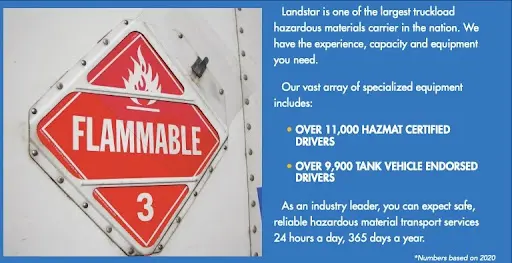Top 5 Considerations for Hazardous Material Hauling
Hazardous Material Hauling
Hazardous material hauling involves transporting substances that could pose a risk to people, property, and the environment if not handled properly. Here are the top 5 things you should consider to ensure safe and compliant hazardous material hauling:
- Regulatory Compliance: It’s crucial to understand and comply with the regulations set by organizations such as the Department of Transportation (DOT) and the Environmental Protection Agency (EPA).
- Proper Training: Haulers should have the appropriate training and certifications to handle hazardous materials safely.
- Equipment and Packaging: The right equipment and packaging are essential to prevent spills, leaks, or other accidents during transportation.
- Emergency Response Plan: Having a well-defined plan in case of emergencies is vital to minimize the impact of any incidents.
- Risk Assessment: Assessing the risks associated with the materials being transported is important to implement suitable safety measures.
Understanding and prioritizing these considerations is fundamental to successful and responsible hazardous material hauling.

Understanding the regulations and compliance
Hazardous material hauling is subject to strict regulations and compliance requirements. It is important to be aware of and adhere to these regulations to ensure the safe transport of hazardous materials. This includes understanding the requirements set forth by organizations such as the Department of Transportation (DOT) and the Environmental Protection Agency (EPA). Failure to comply with these regulations can result in significant fines and penalties, as well as potential harm to the environment and public safety. It is crucial to stay informed and up to date on the ever-changing regulatory landscape to avoid any legal or safety issues.
Choosing the right equipment and vehicles
When it comes to hazardous material hauling, it’s crucial to choose the right equipment and vehicles for the job. Here are the top five considerations to keep in mind:
- Safety Features: Look for vehicles and equipment with advanced safety features designed specifically for handling hazardous materials. This includes secure containment systems, spill prevention measures, and emergency response capabilities.
- Compatibility: Ensure that the equipment and vehicles you choose are compatible with the specific types of hazardous materials you will be hauling. Different materials require different handling and containment solutions.
- Regulatory Compliance: It’s important to select equipment and vehicles that meet all regulatory requirements for transporting hazardous materials. This includes compliance with federal, state, and local regulations, as well as any industry-specific standards.
- Capacity and Efficiency: Consider the capacity and efficiency of the equipment and vehicles, taking into account the volume and frequency of material hauling. It’s essential to balance capacity with cost-effectiveness and operational efficiency.
- Maintenance and Service: Choose equipment and vehicles that are easy to maintain and service, ensuring that they are always in optimal condition for handling hazardous materials. Regular maintenance and prompt servicing are crucial for safe and reliable operations.
Importance of proper training and certification
Proper training and certification are crucial for hazardous material hauling. It ensures that the individuals involved understand the risks associated with handling hazardous materials and know how to mitigate them. According to the National Institute for Occupational Safety and Health (NIOSH), workers must undergo training to recognize the hazards of the materials they handle and understand the necessary precautions. Certification demonstrates that individuals have met specific competency standards and are qualified to handle hazardous materials safely. This helps in preventing accidents, protecting the environment, and ensuring compliance with regulations.
Safety measures and emergency protocols
When it comes to hazardous material hauling, safety measures, and emergency protocols are crucial. Here are some key considerations to keep in mind to ensure the safety of both the haulers and the surrounding environment:
- Proper Training: All personnel involved in hazardous material hauling should receive thorough training on handling, transporting, and responding to emergencies related to hazardous materials.
- Use of Personal Protective Equipment (PPE): Haulers need to use the appropriate PPE, such as gloves, goggles, respirators, and protective clothing, to minimize the risk of exposure to hazardous materials.
- Emergency Response Plan: A comprehensive emergency response plan should be in place, outlining the steps to be taken in case of spills, leaks, or accidents during transportation.
- Regulatory Compliance: Adhering to relevant regulations and standards is crucial for hazardous material hauling to ensure compliance with safety requirements and prevent potential fines or penalties.
- Communication and Monitoring: Effective communication and constant monitoring of the transportation process are essential to promptly address any safety concerns or emergencies that may arise during hauling.
Risk assessment and management
Risk assessment and management are crucial.
Here are the top 5 considerations to keep in mind:
- Identify and evaluate potential risks associated with the hazardous materials being transported.
- Implement effective safety measures to minimize the risks during transportation and handling.
- Train employees on proper handling procedures and emergency protocols in case of accidents.
- Regularly review and update risk management plans to address any new hazards or changes in regulations.
- Work closely with regulatory authorities to ensure compliance with hazardous material transportation laws and regulations.
Environmental impact and sustainability
When it comes to hazardous material hauling, the environmental impact and sustainability are key considerations. Here are the top 5 things to keep in mind:
- Regulatory Compliance: Ensure that all hazardous material hauling activities comply with environmental regulations to minimize the impact on the surroundings.
- Emission Reduction: Implement measures to reduce carbon emissions and air pollution during transportation, such as using eco-friendly vehicles and technologies.
- Waste Management: Properly manage any waste generated during the hauling process to minimize environmental impact and promote sustainability.
- Risk Mitigation: Identify and mitigate potential environmental risks associated with hazardous material transportation to protect ecosystems and communities.
- Sustainable Practices: Embrace sustainable practices such as using recyclable packaging materials and adopting efficient transportation routes to reduce the ecological footprint.
Considering these factors can contribute to responsible and environmentally friendly hazardous material hauling.
Insurance and legal considerations
Before starting hazardous material hauling, it’s crucial to consider insurance and legal requirements. Here are some key points to keep in mind:
- Insurance Coverage: Ensure that your insurance policy covers hazardous material hauling. Some standard insurance policies may not include coverage for this specialized type of transportation.
- Legal Compliance: Familiarize yourself with the regulations and laws regarding hazardous material hauling in your area. This includes obtaining the necessary permits and complying with transportation laws.
- Liability Protection: Understand the extent of liability protection provided by your insurance policy. It’s essential to have adequate coverage in case of accidents or spills during transportation.
- Environmental Responsibility: Be aware of the environmental responsibilities associated with transporting hazardous materials. Ensure that your operations adhere to environmental protection guidelines.
- Legal Representation: Consider having legal representation to navigate the complex legal aspects of hazardous material hauling, ensuring compliance and safeguarding your business from legal implications.
Handling and packaging of hazardous materials
When handling hazardous materials, it’s crucial to ensure proper packaging to prevent any leaks or spills. Here are the top 5 considerations for safe and effective hazardous material hauling:
- Use of certified containers and packaging materials that comply with regulatory standards.
- Secure and label the packages clearly with the appropriate hazard symbols and labels.
- Employ suitable handling procedures to minimize the risk of accidents and exposure.
- Regular monitoring of the condition of the packaging to detect any damage or deterioration.
- Adherence to transportation regulations and guidelines to guarantee the safe delivery of hazardous materials.
When you go with Landstar, you know you have one of the top hazmat shipping companies in the nation. We take great care to protect our clients and to make sure we are doing things the right way. Our company currently has more than 11,000 hazmat-certified drivers and more than 9,900 tanker-endorsed drivers. With a network this large, we are ready to handle your hazardous material shipping needs.
Speak with an RTC Hazardous Materials Logistics Specialist Today! (720) 929-9293
Recent Posts






